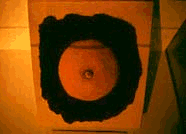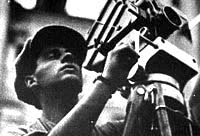
|
 [Cover of the catalog for Le Surrealisme, 1947 by Duchamp]
[Cover of the catalog for Le Surrealisme, 1947 by Duchamp]
This work by Marcel Duchamp, the cover for the catalog of the 1947
exhibition titled Le Surrealisme, organized by Duchamp and Andre Breton,
has a reverse side. The back of the catalog bears the inscription, in
French, "Please Touch". I thought about thi s work almost instantaneously
when I first saw a computer touchscreen positioned over an image, wherein
one is coaxed to "touch" the image, touch the object of desire. It seemed
to me that this link between looking, wanting, and touching, connected
quite directly to these very fundamental urges - to touch the breast, or,
more autonomously, to play with feces. To touch to acquire, to
investigate, to examine the results of ones production... to affirm ones
own existence in the world - the earliest and most durable forms of
agency. Freud writes in Three Contributions to the Theory of Sex ,
"At least a certain amount of touching is indispensable for a person in
order to attain the normal sexual aim. It is also generally known that
touching of the ski n of the sexual object causes much pleasure and
produces a supply of new excitement. ... The same holds true in the end
with looking, which is analogous to touching." This is clear and not at
all surprising- touching is analogous to looking. And it is these two
senses which dominate the field of interactive art.

[Mikhail Kaufman]
The gesture of the hand as that which "opens-up" the work, so that we
might perceive and thereby decipher and interpret its inner
qualifications, can be connected to the fundamental technology of the
moving image itself. Cinema, from the beginnings, was i nvolved with the
physical gesture - the hand-cranked camera, mutoscope, projector. .. - the
gestures which mark the moment of the exposure, the interruption of the
light by the shutter - the cutting of time by the clock crystal in the
circuit, that shift the flow in an interactive work. And these are also
present in the basic reception and choosing of radio and tv - adjusting
the antenna, tuning the dial, the remote-control... This intervention of
the hand is reproduced again and again, marking our ever-ambivalent
relationship to time: we use it, it finishes us....
|
|




